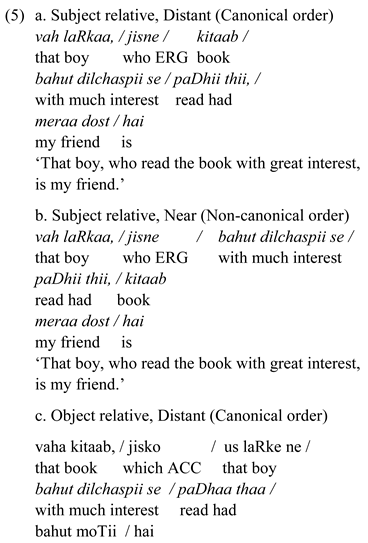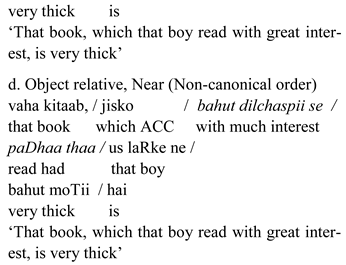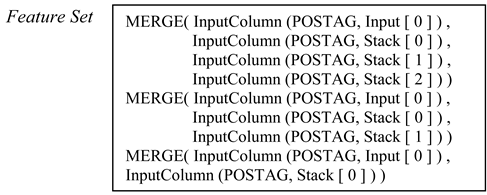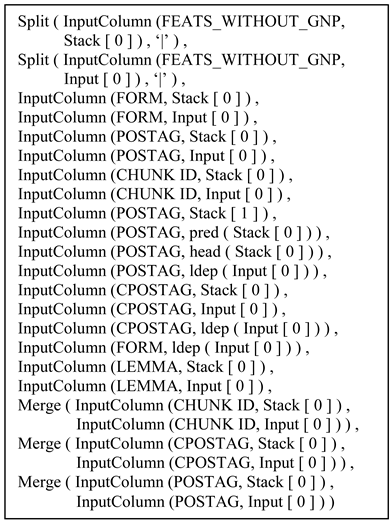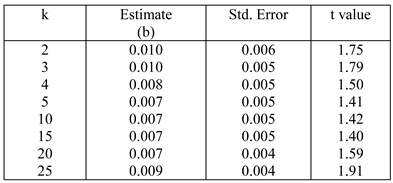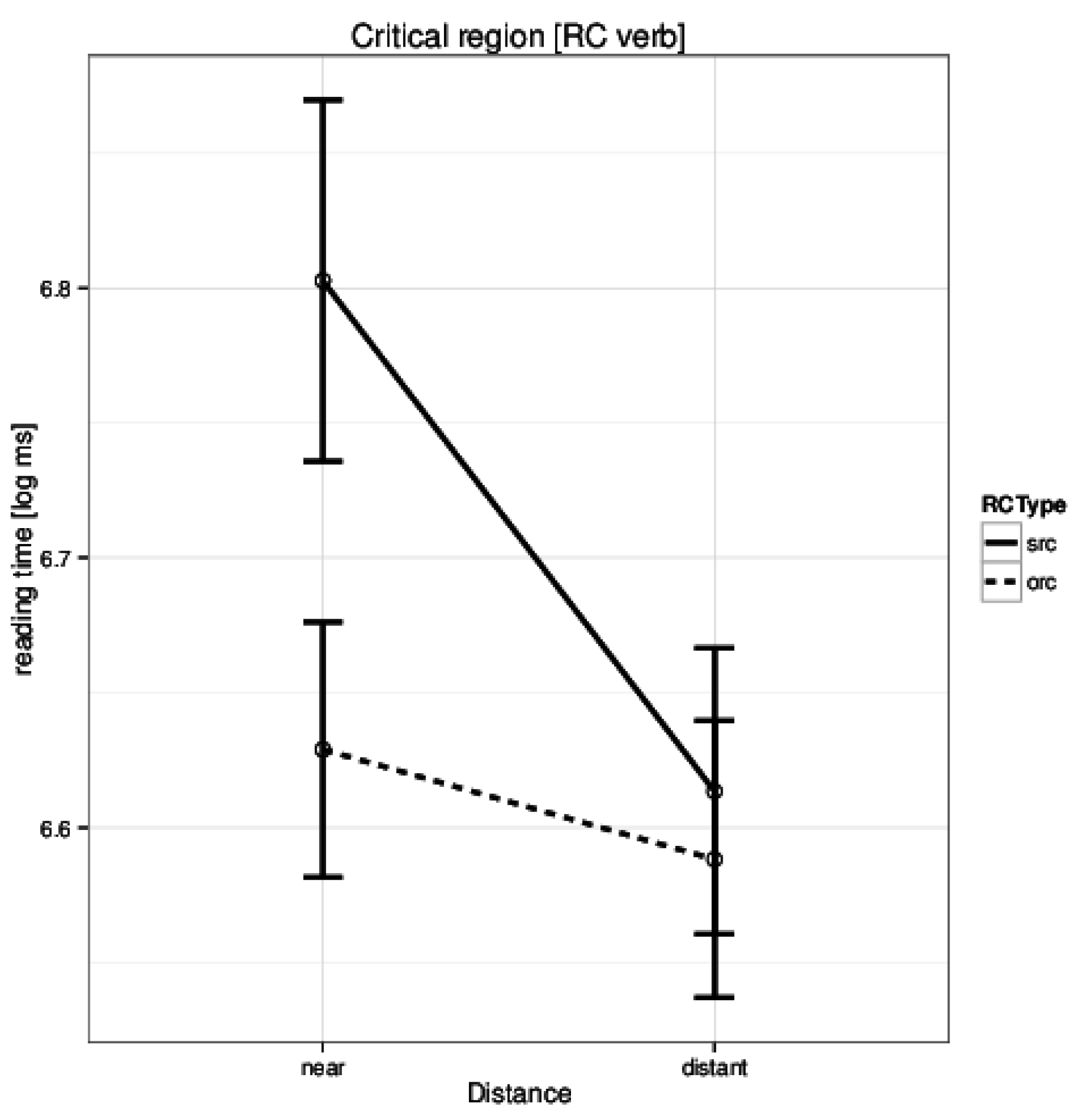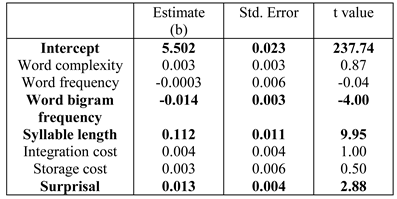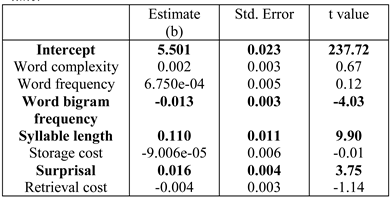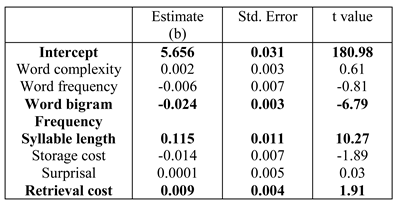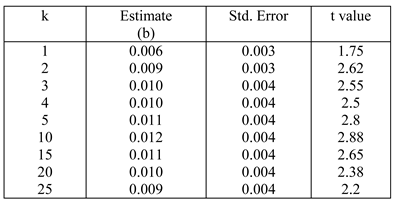Introduction
Eye movements have been successfully employed to uncover cognitive processes that subserve naturalistic reading. Researchers who have been studying eye move-ments have been able to give us very precise models of eye movements along with establishing the link between eye movements and the underlying cognitive processes (see e.g.
Rayner, 1978,
1998; also see, Clifton, Staub, & Rayner, 2007; Vasishth, von der Malsburg, & Engel-mann, 2012).
An eye-tracking corpus typically comprises of natu-ralistic text with eye movement information of all the words that make up the text. Eye-tracking corpora have been used extensively in the area of reading research to model eye movement control in English and German (Reichle, Rayner, & Pollatsek, 2004; Engbert, Nuthmann, Richter, & Kliegl, 2005; Kliegl, Nuthmann, & Engbert, 2006; Kennedy, 2003; Schilling, Rayner, & Chumbley, 1998). For example, using the Potsdam Sentence Corpus,
Kliegl et al. (
2006) showed a significant effect of word frequency, word predictability and word length on fixa-tion durations in German. Their work also argued for a distributed nature of word processing (cf.
Reichle et al., 2004). The Potsdam Sentence Corpus consists of 144 German sentences with fixation duration data from 222 readers. The Dundee eye-tracking corpus (
Kennedy, 2003) is another popular eye-tracking corpus for English. It contains eye-tracking data for 10 participants on 51,000 words of newspaper text in English.
While these corpora have played an important role in the reading research, they have also been used to investi-gate processing theories using naturalistic text in psycho-linguistics (
e.g. Fossum & Levy, 2012;
Frank & Bod, 2011; Mitchell, Lapata, Demberg, & Keller, 2010). In particular they have been used to test both expectation-based (
Hale, 2001;
R. Levy, 2008) and working memory based theories (
Gibson, 2000;
Lewis & Vasishth, 2005) of sentence processing. For example, Demberg and Kel-ler (2008), while investigating the Dundee eye-tracking corpus found that dependency locality theory (DLT) (
Gibson, 1998) successfully predicts reading times for nouns. They also found that an unlexicalized formulation of the surprisal metric (
Hale, 2001) predicts reading times of arbitrary words in the corpus. Similarly, M. Boston, Hale, Kliegl, Patil, and Vasishth (2008) used the Potsdam Sentence Corpus and found that surprisal models all fixation measures as well as regression probability in their data. Further, M. F. Boston, Hale, Vasishth, and Kliegl (2011) used the same Potsdam Sentence Corpus to show that retrieval cost (
Lewis & Vasishth, 2005) is effective in modelling reading times only at a higher degree of parser parallelism. More recently, Frank, Monsalve, and Vigliocco (2013) have constructed an eye-tracking corpora that is intended to serve as the gold standard for testing psycholinguistic theories for English. The data comprises of 361 independently interpretable sentences from a variety of genres; these sentences have different syntactic constructions and therefore the text is meant to be representative of English syntax.
While the relevance of eye movement has been known in the psychology and psycholinguistics literature for some time, it is only recently that eye movement data are being used in various natural language processing applications. For example,
Barrett and Søgaard (
2015a) used fixation patterns and fixation durations to automati-cally predict part-of-speech categories of words in a sen-tence. The key insight for this work is that reading re-search has demonstrated that fixation duration can corre-late with word properties such as its category, e.g. func-tion words are generally skipped while reading. Similar insights were used by them to also predict grammatical functions during parsing (
Barrett & Søgaard, 2015b). While the use of fixation duration for predicting part-of-speech tags and grammatical functions is quite intuitive, some researchers have been able to exploit eye-tracking-based features for as varied a task such as modelling translation difficulty (Mishra, Bhattacharyya, & Carl,
2013), sentiment annotation complexity (Joshi, Mishra, Senthamilselvan, & Bhattacharyya, 2014), sarcasm detec-tion (Mishra, Kanojia, & Bhattacharyya, 2016), and sen-tence complexity (Singh, Mehta, Husain, & RajaKrish-nan, 2016). These works show that reading data is quite rich and has subtle eye movement patterns can be very useful in various applications.
Similar to the work on English and German (M. Bos-ton et al., 2008;
Demberg & Keller, 2008), in a recent work, Husain, Vasishth, and Srinivasan (2015) used an eye-tracking corpus to investigate sentence processing in Hindi. They created the Potsdam-Allahabad Hindi Eye-tracking Corpus which contains eye movement data from 30 participants on 153 Hindi sentences. They used this corpus to show that during Hindi comprehension word-level predictors (syllable length, unigram and bigram frequency) affect first-pass reading times, regression path duration, total reading time, and outgoing saccade length. Longer words were associated with longer fixations and more frequent words with shorter fixations. They also used two high-level predictors of sentence comprehen-sion difficulty, integration and storage cost (
Gibson, 1998,
2000), and found a statistically significant effect on the ‘late’ eye-tracking measures.
The significant effect of storage cost in
Husain et al. (
2015) is interesting because it is the first evidence in favor of this metric in a naturalistic text using the eye-tracking paradigm. Storage cost characterizes the effort required to maintain predictions of upcoming heads in a sentence. On the other hand, current evidence for predic-tive processing in head-final languages such as Japanese, German and Hindi support the predictions of the surprisal metric (
Hale, 2001). The surprisal metric is quite distinct from the storage cost. Surprisal is defined as the negative log probability of encountering a word given previous sentential context. In this study we investigate the contri-bution of these two expectation-based metrics, namely storage cost and surprisal, using the Hindi eye-tracking corpus. While
Husain et al. (
2015) investigated the effect of integration cost in their study to capture working memory constraints during sentence comprehension, we also explore the effectiveness of an alternative working-memory cost – the cue-based retrieval cost (
Lewis & Vasishth, 2005).
Finally, we discuss the role of parser model assump-tions, i.e. the parsing algorithm, feature set etc. on the model predictions. In order to do this we use the comput-ed surprisal to model reading times of a self-paced read-ing experiment (Husain, Vasishth, & Srinivasan, 2014). The reading time data in this SPR experiment is support-ed by predictions made by the surprisal metric. We there-fore wanted to test if the experimental data can also be explained by the automatically computed surprisal val-ues.
Predictive Processes in Language Comprehension
It has long been argued that human sentence pro-cessing is predictive in nature (W. Marslen-Wilson, 1973; W. D. Marslen-Wilson & Welsh, 1978; Kutas & Hillyard, 1984). Recent work in sentence processing has conclu-sively established that prediction plays a critical role during sentence comprehension (
Konieczny, 2000;
Hale, 2001; Kamide, Scheepers, & Altmann, 2003;
R. Levy, 2008), but see
Huettig and Mani (
2016). While the pre-dictive nature of the processing system has been estab-lished, the exact nature of this system is still unclear
- (1)
Subject Relative:
The reporter who sent the photographer to the ed-itor hoped for a good
- (2)
Object Relative:
The reporter who the photographer sent to the ed-itor hoped for a good story
It has been proposed that a comprehensive theory should not only appeal to predictive processing but also be able to simultaneously account for working memory constraints. For example, in his eye-tracking study inves-tigating processing difference in English object vs subject relative clauses such as (2) and (1),
Staub (
2010) finds evidence for both expectation-based processing and local-ity constraints. But these opposing effects are seen at different regions in object relatives. While evidence for surprisal theory is seen at the first noun after the relative pronoun, locality-based effect (which have been argued to reflect working memory constraints) is seen as pro-cessing slowdown at the relative clause verb. This sug-gests that both types of processing accounts are needed in order to capture the experimental data. This idea has been further corroborated by many studies (
e.g. R. P. Levy & Keller, 2013;
Vasishth & Drenhaus, 2011;
Husain et al., 2014).
Husain et al. (
2015) also found the effect of work-ing memory constraints (in terms of integration cost) as well as prediction (in terms of storage cost) in a Hindi eye-tracking corpus. However they did not test for sur-prisal which is an important metric that captures predict-ability. Given that both storage cost and surprisal quanti-fy the predictive processes during comprehension and considering the fact that surprisal has considerable sup-port from experimental work in various languages (in-cluding Hindi), we wanted to explore the relative contri-bution of these metrics in the Hindi eye movement data.
Surprisal
Surprisal assumes that sentence processing is accom-plished by using a probabilistic grammar. Using such a grammar the comprehender can expect certain structures based on the words that have been processed thus far. The number of such probable structures becomes less as more words are processed. Intuitively, surprisal increases when a parser is required to build some low probability structure. Following M.
Boston et al. (
2008), we compute surprisal using prefix probabilities. For a given probabil-istic grammar G, we define prefix probability at the
ith word (αi) as the sum of probabilities of all partial parses (
d) until the
ith words. Surprisal at the
ith word then is the logarithm of the ratio of prefix probability before and after seeing the word. Surprisal is always positive and in general, unbounded. In our computation, we only take the top
k parses based on their likelihoods at each word to compute α
i![Jemr 10 00011 i001]()
In sentence (3), the α (which is defined as the sum of probabilities of the top
k parses) decreases as the sentence progresses, while the negative logarithm of the probabil-ity increases monotonically. Surprisal, thus is the differ-ence of this increasing series. As mentioned previously, there is considerable cross-linguistic support for surprisal, both from eye-tracking data (
Demberg & Keller, 2008;
M. Boston et al., 2008;
M. F. Boston et al., 2011) as well as from experimental work in (among others) English (
e.g. Staub, 2010), German (
e.g. Vasishth & Drenhaus, 2011;
R. P. Levy & Keller, 2013) and Hindi (
e.g. Husain et al., 2014).
Storage Costs
Storage cost (along with integration cost) is a metric proposed by
Gibson (
2000) as part of Dependency Local-ity Theory (DLT). Storage Cost characterizes the pro-cessing load incurred as a result of maintaining predic-tions of upcoming heads in a sentence. To illustrate the diverging predictions of surprisal and storage cost, con-sider the following example:
The storage cost at deepika ko is 1 as a verb is pre-dicted at this point in order for this sentence to end grammatically, this storage cost remains constant as new arguments are encountered before the verb. When the verb (fona kiyaa hai) is encountered the storage cost become 0. Surprisal will predict a processing cost at encountering abhay ne because encountering a noun phrase with an Ergative case at this position is rare (6% of the 175 Ergative-Accusative word order instances in the treebank had non-canonical word-order).
There is some evidence for storage cost from experi-mental data in English (
Gibson, 1998; Chen, Gibson, & Wolf, 2005) and from the eye-tracking data in Hindi (
Husain et al., 2015).
Methodology
Following,
Husain et al. (
2015) we analyze the effect of certain word-level and sentence-level predictors on the eye-tracking measures. Below we list these dependent and independent variables. Finally, we discuss the parser details used to compute the surprisal values.
Variables
Independent Variables/Predictors. All the predictor used in the
Husain et al. (
2015) study are used in this study as well. Syllable length, word complexity, unigram and bigram frequencies are used as word-level predictors. Integration cost and storage cost were the sentence-level predictors. The details of the computation of these predic-tors can be seen in
Husain et al. (
2015). In addition we also use lexical surprisal for each word as a sentence-level predictor.
All predictors were scaled; each predictor vector (cen-tered around its mean) was divided by its standard devia-tion.
Dependent Variables (Eye-tracking Measures). Again, following
Husain et al. (
2015), we present anal-yses for one representative first-pass measure – first-pass reading time, and two representative measures that often show the effects of sentence comprehension difficulty – regression-path duration and total reading time (
Clifton et al., 2007;
Vasishth et al., 2012).
First Pass Reading Time/Gaze Duration on a word refers to the sum of the fixation durations on the word after it has been fixated after an incoming saccade from the left, until the word on the right is seen.
Regression Path Duration/Go-Past Duration is the sum of all first-pass fixation durations on the word and all preceding words in the time period be-tween the first fixation on the word and the first fixation on any word right of this word.
Total Fixation Time is the sum of all fixations on a word.
In our study, storage cost was computed manually.(This information is part of the
Husain et al. (
2015) da-taset) To estimate surprisal, we used an incremental transition-based parser. We implemented our own probabilistic incremental dependency parser in Python. The code for the parser is freely available online:
https://github.com/samarhusain/IncrementalParser.
Parsing Algorithm and Implementation Details
We use the incremental transition-based parsing algo-rithm (Arc-Eager) (
Nivre, 2008) to parse sentences in order to compute surprisal values for each word in a sen-tence. This is similar to the approach of M. F.
Boston et al. (
2011). However, unlike them we compute lexicalized surprisal. This is because an unlexicalized dependency parser for Hindi has very poor accuracy. We used the sentences in the Hindi-Urdu treebank (HUTB) (
Bhatt et al., 2009) to train our parser. See Appendix for more details on the training data and parser accuracy.
A state in a transition-based parser comprises of (a) a stack, (b) a buffer, (c) a word position index, and (d) the partial parse tree. Arc-Eager is a transition-based parsing algorithm that allows four transitions to go from one state to the other. These states are LEFTARC, RIGHT-ARC, REDUCE and SHIFT. A transition may modify the stack, and/or the parse tree and/or may increment the index by at most one count. Not all transitions are allowed on all states. Before the parsing begins, the starting state con-sists of an empty stack, the buffer contains all the words of the sentence to be parsed, index is initialised to zero and since no structure has been formed yet, we have an empty parse tree. As part of the parsing process, transi-tions are applied incrementally till we reach a state where the parse tree is complete, or no transition is allowed on the state.
Our parser starts with the starting state mentioned above. In the first step, it creates a set of states that can be achieved by applying only one transition to the starting state. For example, we can use SHIFT to transfer the first word from the buffer on to the stack. In the second step, we create a set of states that can be achieved by applying only one transition to those states in the previous set, where the index is still 1. For example, given the first word on the stack, we can either apply LEFT-ARC, RIGHT-ARC or SHIFT. REDUCE is prohibited because the first word has not been assigned a head yet. We keep applying all possible transitions to each state, until all states have index 1. This is the set associated with index 1.
We now use this set and repeat the above procedure till we get a set that only has states with index 2. While applying these transitions, we might end up with some states on which no transitions are legal. We simply drop such states. Thus we keep creating these sets for each value of index starting from one.
As one would guess, the number of elements in the set increases exponentially with the index. Therefore to keep our algorithm tractable, we limit the size of the set of states corresponding to each index to utmost k most prob-able elements. We use a MaxEnt model to output proba-bilities of each transition we apply. The probability of a state is simply the product of the probabilities of all the transitions made to achieve that state.
The prefix probability corresponding to index i is the sum of probabilities of states corresponding to the index i. Surprisal at index i is computed as the log-ratio of pre-fix probability at index (i-1) and prefix probability at index i.
Here we briefly discuss the surprisal computations for each word in example (3). The surprisal values are shown in
Table 1 while maintaining k=3. When we see the first word
dilli, there are four possible transitions according to the Arc-Eager algorithm. A REDUCE or LEFT-ARC operation is not possible at the first word hence we are left with only two possible partial parses. The maximum number of parses we can maintain is greater than that (since
k=3), thus we do not discard any of the potential partial parses. As a result the probability at the first word is 1, and the surprisal is 0. As we move further in the sentence, we see the word
meediaa. At this stage, each of the two partial parses from the previous word can give rise to multiple partial parses, the total number being six. Here the sum of the probabilities of all the six partial parses would be 1, but we only take the three most prob-able ones, the sum of whose probabilities is 0:99997, giving rise to a surprisal of 0.00003. Note that the sur-prisal value will be low when the probability of remain-ing
k parses is higher. This happens when the probability mass is distributed less uniformly with some parses being much more probable than the others. In other words, surprisal is lower when the parser can figure out with a greater degree of certainty, which partial parse is the correct one. Note how in
Table 1 the post-position
kaa has very little surprisal since post-positions routinely follow nouns. However, a proper noun such as
makkaa-madinaa is not expected here (due to low frequency); this leads to a higher surprisal value.
Discussion
The results shown in
Table 2, Table 3 and
Table 4 are consistent with those reported in
Husain et al. (
2015). Like the previous study we find robust effect of word-level predictors, such as word frequency, bigram frequency, and word length. We also find a significant effect of sentence-level pro-cessing predictors, storage cost and integration cost in total fixation time and regression path duration respec-tively.
In this study we introduced a new sentence processing measure, surprisal, as a predictor to investigate different eye-tracking measures. The role of surprisal had not been explored by
Husain et al. (
2015). Our results show a significant effect of surprisal on log first pass reading time. Research on eye-tracking data in other languages such as English (
Demberg & Keller, 2008) and German (
M. Boston et al., 2008) have also found significant effect of surprisal. Our work supports this line of research. Interestingly, surprisal is a significant predictor in addi-tion to bigram frequency. Since bigrams are known to capture local word predictability due to high collocation frequency, it can be argued that surprisal values in this study account for non-local syntactic predictability. Ex-perimental studies on sentence processing in Hindi (e.g.,
Vasishth & Lewis, 2006;
Kothari, 2010;
Husain et al., 2014) have found evidence for predictive processing that can be explained through surprisal.
Further, our results also support previous research both using eye-tracking data (
Demberg & Keller, 2008;
M. F. Boston et al., 2011) as well as experimental data (
e.g. Staub, 2010;
Vasishth & Drenhaus, 2011;
R. Levy, 2008;
Husain et al., 2014) that have shown that both expectation-based metric as well as memory-constraint metric are required to explain processing in various lan-guages such as English, German and Hindi. The results in this study show that surprisal (which captures expecta-tion) as well as integration cost (which captures working-memory constraints) are independent predictors of read-ing time during naturalistic reading in Hindi. The signifi-cant effect of integration cost in our study goes contrary to certain proposals that have argued that head-directionality in a language determines locality vs anti-locality effects (
R. P. Levy & Keller, 2013). Interestingly, while surprisal shows a significant effect in first pass reading time, integration cost is significant only in re-gression path duration. This might point to a temporal disjunction with regard to working memory and predic-tion effects, however more work needs to be done in order to back this claim.
Recall that both surprisal and storage cost are moti-vated by predictive processing concerns. While surprisal captures the probability of a word given previous context, storage cost models the processing difficulty due to head prediction maintenance. Our results show that these two metrics might be capturing independent aspects of predic-tive processing. The correlation between storage cost and surprisal is marginal (r=-0.15). It is important to point out that so far there is no experimental support for storage cost in Hindi while there is support for surprisal. The reason for high storage cost in the Hindi eye-tracking data is varied, but it mostly happens in constructions with embedded structures. These embeddings include both verbal embeddings as well as complex noun phrases. There are some proposals that have argued for processing difficulty in English center-embeddings due to prediction maintenance (
Gibson & Thomas, 1999) (also see, Va-sishth, Suckow, Lewis, & Kern, 2010). Interestingly, surprisal shows up significant only in first pass reading time, while the storage cost seems to be a late emerging effect. The exact role of storage cost in Hindi sentence processing and its relation with surprisal will need further investigation.
General Discussion
Our results are consistent with previous work on natu-ralistic reading in Hindi (
Husain et al., 2015). Results show the role of word-level predictors such as word fre-quency, word bigram frequency, word length, as well as sentence-level predictors such as storage cost, integration cost and surprisal. Building on previous work we demon-strated that both storage cost as well as surprisal are sig-nificant predictors of reading time. While surprisal shows up in an early measure, storage cost appears in a late measure. This could point to reflecting distinct predictive processes.
While the surprisal metric as computed by the transi-tion-based parser was found to be a significant predictor of first pass reading time, we wanted to see if it could also account for some of the experimental data in Hindi.
If some experimental data cannot be accounted by our automatically computed metric but can be theoretically explained by surprisal, then this will highlight the limita-tions of the parsing model that we employ. We discuss this next.
Role of parsing model
Self-paced reading experiment data from
Husain et al. (
2014) was used in order to test the prediction of the computed surprisal on the experimental data. In particular we use the Experiment 1 reading time data from their study. The experiment had a 2×2 design crossing relative clause type and verb distance from the relative pronoun. Examples 5 shows all the four conditions. The key ma-nipulation was that the relative clause verb
paD-hii/paDhaa thii ‘read’ was either ‘near’ or ‘distant’ from the relative pronoun
jisne/jisko. In particular, the near condition although bringing the verb closer to the relative pronoun disrupted the default SOV word order in Hindi. For example, the object
kitaab ‘book’ in Subject relative, Near (Non-canonical order) condition appears after the RC verb.
![Jemr 10 00011 i007]()
![Jemr 10 00011 i008]()
One of the key results was that Hindi native speakers took longer to read the critical relative clause verb in the short condition. This can be seen in
Figure 1. Surprisal can easily explain this pattern – in the subject relative clause the presence of Ergative case-marker on the rela-tive pronoun predicts a transitive verb. Since the default word order in Hindi is SOV, an object is also expected to appear before the verb. In the ‘near’ condition the verb appears before the object thus negating this expectation.
The Hindi native speaker is therefore surprised to see the RC verb in this position leading to a higher reading time.(
Husain et al. (
2014) also found a significant interaction effect, but this is not critical for the discussion here. Sur-prisal can also explain the interaction effect.)
As stated earlier, the ‘near’ conditions is expected to see a higher surprisal at the relative clause verb. It is therefore expected that the surprisal values computed by the parser should be higher in the near condition com-pared to distant condition. Surprisingly, we got the exact opposite results (t(23) = 4.6, p-value = 0.0001; mean of differences 0.14, 95% CI 0.08, 0.21). The t-test implied that surprisal, as calculated by us, does not account for the theoretical prediction of the surprisal metric in the case of these sentences. At the same time, the surprisal values computed by the parser have a significant effect on First-Pass Reading Time during naturalistic reading of the data discussed earlier. This shows that certain lexi-cal/syntactic processes are being captured by the comput-ed metric. One possible reason for this anomaly could be the nature of the parsing model that we use.
Two aspects of the parser model is worth highlighting here. First, transition-based models such as the one used in this study are known to take very local decision while ignoring the global sentential configuration (
Zhang & Nivre, 2011). This has been shown to adversely affect its performance in case of word order variability (
Gulordava & Merlo, 2016). Previous work on modelling experi-mental data using surprisal have mainly used phrase structure parsers (
Hale, 2001;
R. Levy, 2008). These parsers assume a probabilistic phrase structure grammar (PCFG) that is induced from a treebank. The grammar rules in PCFG are directly associated with probabilities that are used to compute prefix probabilities. These prefix probabilities are then used to compute surprisal. These phrase structure rules (and therefore the associated pars-ing) can potentially capture the argument structure varia-bility better compared to the dependency parsing using a transition-based system. Such an approach requires the availability of a phrase-structure treebank which is cur-rently not available for Hindi.
The second aspect of the parser model relates to the feature set and labeled parsing. Our original feature set did not have the transitivity information of the verb. We tried adding transitivity information and more global features like the information about its first and second
left-dependents but that led to reduction in parser accura-cy. Further we could not add information about the de-pendency relation of the verb with its left-dependents since we were doing an unlabeled parsing. Perhaps a labeled parser might be able to capture this notion of surprisal. We intend to investigate this in future work.
So, while the automatically computed surprisal values do account for some variance in the eye movement data from naturalistic reading in Hindi, it is unable to correctly predict the experimental data discussed above. This shows that properties such as parser algorithm, feature set, grammar assumptions, etc. are critical for the predic-tive power of a parsing model. Investigating such proper-ties will be critical in order to account for experimental data such as
Kamide et al. (
2003); R. P.
Levy and Keller (
2013), etc. For example,
Kamide et al. (
2003) argued that German native speakers are able to use the case-marking of the subject along with the selectional-restriction of the verb to predict the most appropriate object before its auditory onset. Similarly, R. P.
Levy and Keller (
2013) have argued that introducing a dative case-marked noun phrase leads to facilitation at the verb in German. This is presumably because the dative case-marked noun phrase makes the prediction of the upcom-ing verb more precise.
Similar to our results
Demberg and Keller (
2008) did not find an effect of integration cost in first pass reading time.(Actually, they found an effect but with a negative coef-ficient which is inconsistent with the claims of the de-pendency locality theory.) M. F.
Boston et al. (
2011), on the other hand used an alternative metric to integration cost – retrieval cost, and found it to be significant for all measures for higher values of parser parallelism. One reason for the differing results in these studies could be that retrieval cost cap-tures working memory constraints over and above what integration cost captures. We discuss this issue next.
Retrieval cost: An alternative to integration cost
Similar to the study by M. F.
Boston et al. (
2011), we calculate retrieval based on the cue-based activation model (
Lewis & Vasishth, 2005). The time taken to re-trieve a chunk from the memory depends on its activation cost which is given as:
The activation of a memory chunk depends on two factors: decay and interference. This is shown in the fol-lowing equation:
Here
Bi is the decay term which ensures higher re-trieval time if the word was last retrieved from the memory in the distant past. If
t n denote the set of times when the
ith word was retrieved,
Bi is given by:
The interference term ensures that higher interference in retrieval (i.e. memory chunks with overlapping fea-tures) implies higher retrieval cost. It is computed as a weighted sum of
Sjis which represent the strength of asso-ciation.
where
fanj is the number of chunks that have the same feature as the
jth retrieval cue. In our model, similar to M. F.
Boston et al. (
2011), the part-of-speech category acts as a feature/cue and
Smax is set to 1.5. Finally, productions in ACT-R are assumed to accrue a fixed cost of 50 ms and reading a cost of 1 ms to execute. Formation of a dependency arc accrues the cost of a retrieval along with two productions and a SHIFT operation accrues only one production cost.
While testing for the effect of retrieval, we leave out integration cost (IC) from the set of predictors since IC and retrieval are highly correlated (r=0.53). This is not surprising as both these measures formalize retrieval cost at the integration site. Also, like M. F.
Boston et al. (
2011), we only consider points where the retrieval cost is non-zero and thus an effect of retrieval cost is expected.
The overall results are quite similar to those obtained earlier.(The significant effect of storage cost in
Table 6 is in-consistent with the results discussed previously. We have no explanation for this effect.) Interestingly, while retrieval cost is not signifi-cant for any of the three dependent measures for
k=10; when the value of
k is increased to 25, retrieval cost be-comes marginally significant in the case of RPD (
Table 8). This seems to validate the results of M. F.
Boston et al. (
2011) who also found significant effects of retrieval cost for higher parser parallelism. However, unlike them we did not find a significant effect of retrieval cost for all measures. The results without excluding points with zero retrieval cost are also very similar to the ones mentioned below, hence we skip them for brevity.
How much (cross-linguistic) generalization can be drawn from our work and the eye-tracking corpus-based investigation in English and German? All these studies have found the effect of surprisal as well as memory costs on various eye movement measures. However, the exact measures for which these metrics are significant differ. For example, in this study we find the effect of surprisal only in first pass reading time, while M. F.
Boston et al. (
2011) found the effect of (unlexicalized) surprisal for both early and late measures. In Demberg and Keller’s (2008) study, the lexicalized surprisal does not show up in the results for first pass reading time. So, while there are some broad agreement between these results, because the modeling assumptions with respect to treebank anno-tations, parsing algorithm, nature of the predictors, pars-ing feature set, etc. are so varied, it is difficult to make any specific claims about cross-linguistics generaliza-tions. A much more controlled modeling setup is needed in order to make any reasonable claim.


